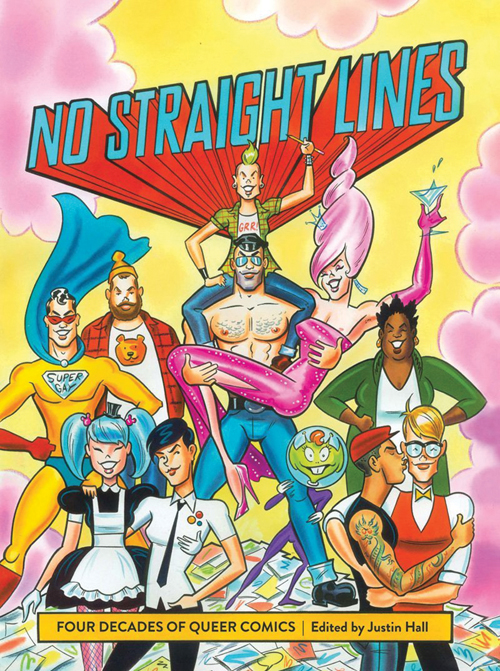
‘No Straight Lines’
 The value of queer comics
The value of queer comics
by Kit van Cleave
No Straight Lines, an anthology of gay comics collected and edited by Justin Hall, was first printed in May 2012. But given its edgy nature, it was not reviewed in mainstream print or air media until the end of that year, when a discussion of the book finally came out in the New York Times. I spent several months trying to order a copy, only to find Amazon unable to produce one until very recently. Today, copies are more easily found, and this work is highly recommended for its artistic creativity and ample 307 pages of beautifully reproduced drawings.
Hall had plenty of places to find these creative works given, as he states, the “wide range of subjects, themes, and styles in this unique and vibrant artistic underground.” But the research must have been daunting. The reason for these comics to exist in the first place was the lack of communication among various parts of the national gay community. Moreover, “queer cartooning,” as Hall puts it, was and had long been marginalized, very rarely getting any shelf space at comic book stores, or awards, or attention at comic conventions and events.
In a short introduction, the editor gives a history of gay comics, created for artistic expression and awareness of a growing wider audience. Hall begins with Touko Laaksonen, “the first gay cartoonist,” publishing in the mid-1940s, selling through mail-order in Europe. In 1957 Laaksonen began illustrating Physique Pictorial, using the pen name Tom of Finland. With the weakening of the U.S. obscenity laws in the 1960s, Laaksonen was, with contemporaries, able to distribute erotic gay cartoons openly.
When the Stonewall riots occurred in 1969, a wave of gay magazines and newspapers surged in New York, and needed comics, particularly strips like Joe Johnson’s “Miss Thing” and Sean’s “Gayer than Strange.” Underground comics “exploded in San Francisco,” with Robert Crumb publishing the first issue of Zap Comix in 1968. While part of the overall California political scene included comics by straight men, Hall reports, they broke boundaries with depictions of sex, drugs, and other such adult topics, and “tended toward misogyny and homophobia.”
Another leading artist in the early days was Trina Robbins, who in 1970 published It Ain’t Me, Babe Comics, the first all-female comic anthology, followed by Come Out Comix in l973, born in the basement of a local women’s karate school. Gay Comix arrived in 1980m, with major contributions by Howard Cruse, who was already producing Barefoot as a series; it survived for twenty-five issues during the next eighteen years. From the leather subculture of Cologne came the work of Ralf Konig, from Holland Tom Bouden, and from France Fabrice Neaud, but still Europe was less developed in the artform than America.
Among those struggling to keep working in the field was Alison Bechdel; her Dykes to Watch Out For was first seen in 1983; unlike earlier times, however, enough gay publications existed by that era that a fledgling cartoonist could make close to a living wage. The call for closer community arrived along with the AIDS crisis in 1983, while outside the fences a backlash against gays roared, almost demolishing the community so carefully created underground. Queer cartoons could still educate, entertain, and move emotions, so the number of artists then working in the field become too numerous to list here, even in Hall’s introduction.
Undoubtedly this is a valid and sought-after means of expression with a widening audience. Many of the comics included in Hall’s book could be enjoyed by both straight and gay people. I regret the book’s visuals could not be reproduced here.
Editor’s note: The New York Times Book Review discussion of No Straight Lines can be found in the December 2, 2012, archive. First publication was by Fantagraphics Books, Inc., 7563 Lake City Way NE, Seattle, WA 98115.
Kit van Cleave is a freelance writer living in Montrose. She has published in local, national, and international media.











FB Comments